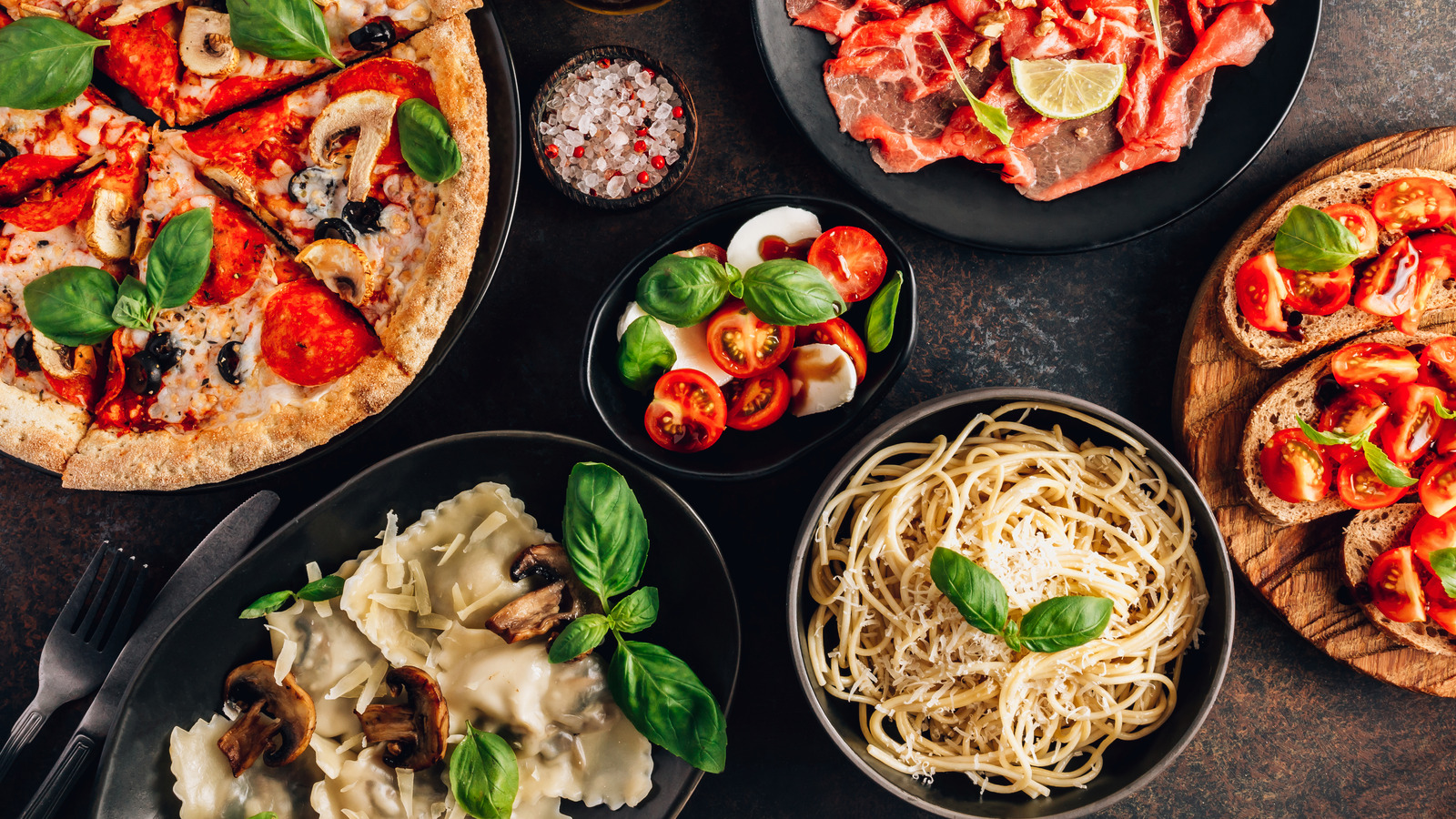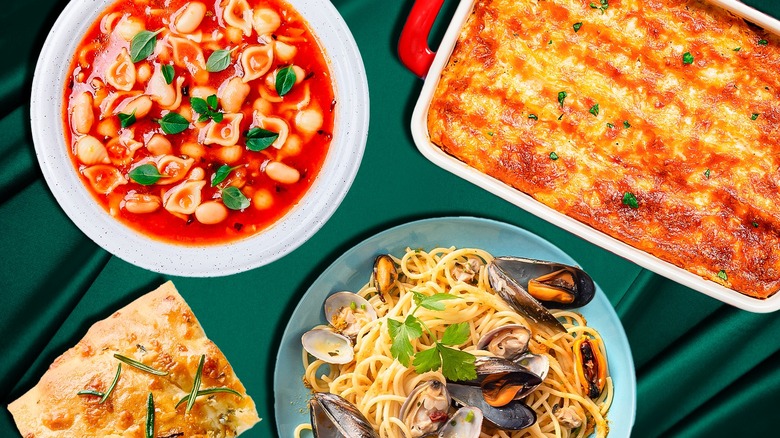Italian food simplicity, a culinary philosophy that has captivated taste buds for centuries, embodies the essence of freshness, balance, and regional authenticity. Rooted in the traditions of local ingredients and time-honored techniques, Italian cuisine celebrates the natural flavors of its components, resulting in dishes that are both vibrant and unpretentious.
From the rolling hills of Tuscany to the sun-kissed shores of Sicily, Italian food simplicity manifests itself in a myriad of regional variations, each influenced by unique geographical factors and culinary customs. The result is a tapestry of flavors and textures that reflects the rich cultural heritage of Italy.
Historical Roots of Italian Food Simplicity
The simplicity of Italian cuisine has its roots in the country’s history and culture. The use of local ingredients, traditional cooking techniques, and a focus on fresh, seasonal produce have all contributed to the development of a cuisine that is both delicious and approachable.
Local Ingredients
Italy is a country with a diverse landscape, from the fertile plains of the Po Valley to the rugged mountains of the Alps. This diversity has resulted in a wide range of local ingredients that are used in Italian cooking.
From the fresh seafood of the Mediterranean coast to the truffles of the Piedmont region, each region of Italy has its own unique culinary traditions.
Traditional Cooking Techniques
Italian cooking techniques have been passed down through generations. These techniques, such as slow-cooking, braising, and grilling, are designed to enhance the flavor of the ingredients without overpowering them. Italian cooks also make extensive use of herbs and spices, which add depth and complexity to dishes.
Classic Italian Dishes
Some of the most classic Italian dishes exemplify the simplicity of the cuisine. These dishes, such as pasta with tomato sauce, risotto, and pizza, are made with a few simple ingredients that are combined to create a delicious and satisfying meal.
Ingredients and Preparation Methods
Simplicity in Italian cooking shines through in the use of fresh, seasonal ingredients. From ripe tomatoes to fragrant basil, each ingredient is carefully selected to preserve its natural flavors. Traditional preparation methods further enhance these flavors, allowing them to speak for themselves.
Preserving Natural Flavors
Italian cooking emphasizes techniques that preserve the natural flavors of ingredients. Grilling, roasting, and sautéing are common methods that allow the ingredients to caramelize and develop rich flavors without overpowering them.
Grilling
Grilling over hot coals or an open flame imparts a smoky, charred flavor to meats, vegetables, and seafood. The high heat quickly sears the outside, locking in juices while creating a flavorful crust.
Roasting, Italian food simplicity
Roasting in an oven allows ingredients to cook slowly and evenly, developing a golden-brown exterior and tender interior. Vegetables, meats, and poultry all benefit from this method, as the natural juices are retained, resulting in flavorful and succulent dishes.
Sautéing
Sautéing involves cooking ingredients in a pan with a small amount of fat. This method is often used for vegetables, herbs, and meats, and allows for quick and even cooking while preserving the natural flavors.
Regional Variations and Influences

Italian cuisine is renowned for its simplicity and reliance on fresh, local ingredients. However, there is a remarkable diversity of regional variations within Italian cooking, each with its own unique characteristics. These variations are largely influenced by geographical factors, such as climate, available ingredients, and cultural traditions.
Geographical Factors
The climate of Italy varies significantly from the temperate north to the warm and sunny south. This variation in climate has a profound impact on the types of ingredients that are available in each region. For example, the northern regions of Italy are known for their rich dairy products, such as Parmigiano-Reggiano cheese and butter, while the southern regions are known for their abundance of fresh fruits and vegetables, such as tomatoes, olives, and citrus fruits.
The availability of local ingredients has also played a significant role in shaping the regional variations of Italian cuisine. For example, the Ligurian coast is known for its seafood dishes, such as pesto and focaccia, while the mountainous regions of Abruzzo and Molise are known for their hearty meat dishes, such as arrosticini and lamb chops.
Cultural Traditions
In addition to geographical factors, cultural traditions have also influenced the regional variations of Italian cuisine. For example, the region of Emilia-Romagna is known for its rich culinary tradition, which includes dishes such as tortellini, lasagna, and balsamic vinegar. This culinary tradition is largely due to the region’s history as a crossroads of trade and commerce, which brought together a variety of influences from different cultures.
Table of Regional Variations
The following table provides a summary of the key characteristics of Italian dishes from different regions:
| Region | Characteristics |
|---|---|
| Northern Italy | Rich dairy products, hearty meat dishes, polenta |
| Central Italy | Pasta dishes, grilled meats, olive oil |
| Southern Italy | Fresh fruits and vegetables, seafood, spicy dishes |
| Islands (Sicily and Sardinia) | Arab and Spanish influences, couscous, seafood, grilled meats |
The Role of Seasonality and Freshness

Seasonality is a cornerstone of Italian cuisine, dictating the availability and quality of ingredients used in traditional dishes. Italian chefs embrace the concept of “mangiare di stagione,” or eating with the seasons, to ensure that their dishes showcase the freshest and most flavorful produce.By
sourcing ingredients that are at their peak ripeness, Italian chefs create vibrant and aromatic dishes that burst with natural flavors. In spring, for instance, dishes feature tender asparagus, artichokes, and peas, while summer brings an abundance of juicy tomatoes, zucchini, and eggplants.
Autumn ushers in earthy mushrooms, chestnuts, and pumpkin, and winter brings hearty greens like kale and radicchio.
Freshness in Italian Cooking
Freshness is paramount in Italian cooking. Italian chefs prioritize using ingredients that have been recently harvested or caught to preserve their delicate flavors and textures. This emphasis on freshness extends to herbs and spices, which are often used liberally to enhance the natural flavors of the main ingredients.For
example, a simple pasta dish like spaghetti al pomodoro relies on the freshness of ripe tomatoes, fragrant basil, and tangy Parmesan cheese to create a harmonious balance of flavors. Similarly, a classic caprese salad showcases the freshness of ripe tomatoes, creamy mozzarella, and aromatic basil, with a drizzle of extra virgin olive oil adding a touch of richness.
The Importance of Balance and Harmony

In Italian cuisine, the principles of balance and harmony play a pivotal role in creating dishes that are both visually appealing and tastefully satisfying. Italian chefs strive to achieve a delicate equilibrium of flavors, textures, and colors, resulting in dishes that are harmonious and well-rounded.
One key aspect of balance in Italian cooking is the combination of contrasting flavors. Sweet and sour, bitter and sweet, and salty and sweet are common flavor combinations that add complexity and interest to dishes. For instance, the classic pairing of sweet balsamic vinegar with salty Parmigiano-Reggiano cheese creates a harmonious balance of flavors.
Texture
Texture also plays a crucial role in achieving balance. Italian cuisine features a wide range of textures, from the crispiness of fried zucchini flowers to the velvety smoothness of risotto. Chefs carefully combine different textures to create dishes that are both visually appealing and satisfying to eat.
For example, a dish of tender pasta is often paired with a crunchy topping, such as toasted breadcrumbs or grated cheese, to add textural contrast.
Color
Color is another important element of balance in Italian cooking. Italian dishes are often vibrant and colorful, featuring a variety of fresh ingredients such as tomatoes, peppers, and herbs. Chefs use color to create visually appealing dishes that stimulate the appetite.
For instance, a traditional Italian salad might include a mix of colorful vegetables, such as red tomatoes, green bell peppers, and yellow onions, to create a visually striking and balanced dish.
FAQs: Italian Food Simplicity
What is the secret behind Italian food simplicity?
The simplicity of Italian cuisine lies in its focus on fresh, seasonal ingredients and traditional cooking techniques that preserve their natural flavors.
How do regional variations influence Italian food simplicity?
Italy’s diverse geography and climate give rise to distinct regional variations, each with its own unique ingredients and culinary traditions that contribute to the overall simplicity of Italian food.
What is the importance of balance and harmony in Italian cooking?
Italian chefs strive to create dishes that are harmonious in terms of flavors, textures, and colors, ensuring that each element complements the others to produce a cohesive and satisfying culinary experience.
